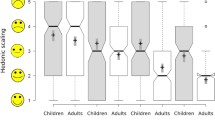Abstract
To ensure optimal, reliable treatment, it is necessary to investigate the efficacy, safety and the optimal dose of drug substances and to develop suitable age-specific pharmaceutical formulations for the different paediatric age groups due to a lack of evidence-based therapeutic options for children. While WHO recommends the use of solid dosage forms in general, European Medicines Agency (EMA) requires evidence for the suitability of these dosage forms in the targeted age group. This review aims to summarize and discuss the data obtained in acceptability studies on the suitability of coated and uncoated mini-tablets in children of different ages in comparison to a sweet syrup considered as gold standard. The predefined outcome parameters ‘acceptability’ and ‘capability to swallow’ of the two different mini-tablet formulations (uncoated and film-coated) were statistically significantly higher than that of the syrup.


Similar content being viewed by others
Abbreviations
- EMA:
-
European Medicines Agency
- mm:
-
Millimetres
- ml:
-
Millilitres
- p :
-
Statistical power
- PIP:
-
Paediatric investigation plan
- WHO:
-
World Health Organization
References
European Parliament and the Council. Paediatric Regulation (EC) No 1901/2006 of the European Parliament and of the Council of [12] December 2006, on medicinal products for paediatric use and amending Regulation (EEC) No 1768/92, Directive 2001/20/EC, Directive 2001/83/EC and Regulation (EC) No 726/2004. Official Journal of the European Union L 378/1; 2006.
Yeung VW, Wong IC. When do children convert from liquid antiretroviral to solid formulations? Pharm World Sci. 2005;27:399–402.
Breitkreutz J, Wessel T, Boos J. Dosage forms for per oral administration to children. Paediatr Perinatol Drug Ther. 1999;3:25–33.
Breitkreutz J. European perspectives on pediatric formulations. Clin Ther. 2008;30:2146–54.
World Health Organisation (WHO). EB. Campaign “Make medicines child size”. Progress Reports, Reports by the Secrtariat; 2008. http://apps.who.int/gb/ebwha/pdf_files/EB124/B124_33Add1-en.pdf
European Medicines Agency (EMA) CfMPfHU. Reflection paper: formulations of choice for the paediatric population. EMEA/CHMP/PEG/194810/2005; 2006.
European Medicines Agency (EMA) CfMPfHU. Guideline on pharmaceutical development of medicines for paediatric use. EMA/CHMP/QWP/805880/2012 Rev. 2; 2013. http://www.ema.europa.eu/docs/en_GB/document_library/Scientific_guideline/2013/07/WC500147002.pdf
Thomson SA, Tuleu C. Mini-tablets: new modality to deliver medicines to preschool-aged children. Pediatrics. 2009;123(2):e235–238.
Van de Vijver E, Desager K, Mulberg AE, Staelens S, Verkade HJ, Bodewes FA, et al. Treatment of infants and toddlers with cystic fibrosis-related pancreatic insufficiency and fat malabsorption with pancrelipase MT. J Peadiatr Gastroenterol Nutr. 2011;53(1):61–4.
van Riet-Nales DA et al. Acceptability of different oral formulations in infants and preschool children. Arch Dis Child. 2013;98(9):725–31.
Kluk A, Sznitowska M, Brandt A, Sznurkowska K, Plata-Nazar K, Mysliwiec M, et al. Can preschool-aged children swallow several minitablets at a time? Results from a clinical pilot study. Int J Pharm. 2015;485(1–2):1–6.
Spomer N, Klingmann V, Stoltenberg I, Lerch C, Meissner T, Breitkreutz J. Acceptance of uncoated mini-tablets in young children: results from a prospective exploratory cross-over study. Arch Dis Child. 2012;97:283–6.
Klingmann V, Spomer N, Lerch C, Stoltenberg I, Frömke C, Bosse HM, et al. Favorable acceptance of mini-tablets compared with syrup: a randomized controlled trial in infants and preschool children. J Pediatr. 2013;163(6):1728–32.
Klingmann V, Seitz A, Meissner T, Breitkreutz J, Möltner A, Bosse HM. Acceptability of uncoated mini-tablets in neonates—a randomized controlled trial. J Pediatr. 2015;167:893–6.
Author information
Authors and Affiliations
Corresponding author
Ethics declarations
Conflict of Interest
The author declares that she has no conflicts of interest.
Additional information
Guest Editors: Maren Preis and Jörg Breitkreutz
Rights and permissions
About this article
Cite this article
Klingmann, V. Acceptability of Mini-Tablets in Young Children: Results from Three Prospective Cross-over Studies. AAPS PharmSciTech 18, 263–266 (2017). https://doi.org/10.1208/s12249-016-0639-3
Received:
Accepted:
Published:
Issue Date:
DOI: https://doi.org/10.1208/s12249-016-0639-3




